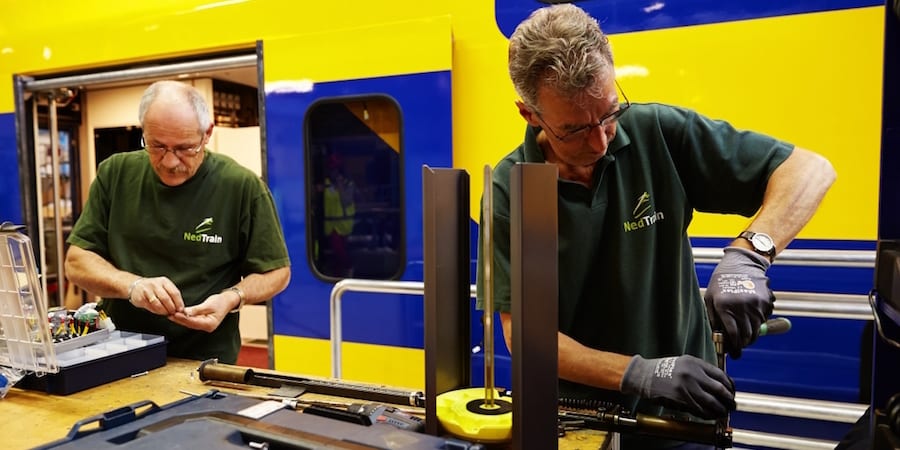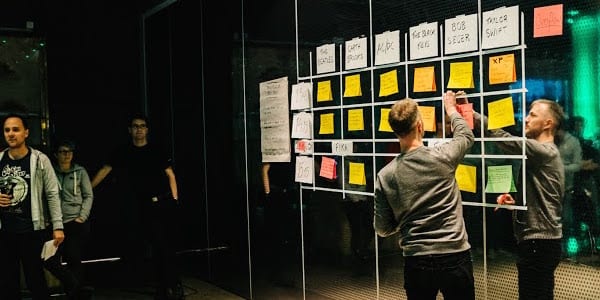
Lean thinking in the HR department of Dutch railways
FEATURE – Faced with long lead-times to hire new people and with tens of millions paid in sick leave every year, the HR department of Dutch railway operator NS has turned to lean thinking to set them on the right track for the future.
Words: Erik Steenbakkers, Director of HR Center of Expertise, NS NL
If you have been to the Netherlands, you are likely to have seen (or even ridden) one of our distinctive yellow and blue trains. But there is more to Nederlandse Spoorwegen, or NS. Sure, we run almost 5,000 services every day, moving over one million people, but we also maintain and service trains and buses and manage hundreds of stations. We have subsidiaries in Germany, Poland, and England.
Our organization is extremely large and multi-faceted (we employ 21,000 people in the Netherlands, and an extra 12,000 in the rest of Europe) and faces a number of challenges, including an aging workforce and a continuous struggle to find the right talent, in the right spot at the right time.
In a bid to tackle these pressing issues, the organization decided to centralize (within local departments) staff services like Procurement, IT, Finance and HR. Within HR, we also established three Centers of Expertise (Employee Life Cycle is one of them) – their purpose is to support the sustainability of the organization from a human resources perspective, which means having available, capable, flexible and healthy staff on our payroll.
At the moment we are focusing on three factors that influence sustainability and that our 65-strong team can act on:
- Recruitment – Every year the HR department hires some 4,500 people to replace staff members who are no longer working for NS or who are on sick leave. This process includes searching for and selecting the right talent, as well as hiring and part of the onboarding.
- Occupational mobility in support of employability – It is important for people to be able to seamlessly and quickly move around in the organization, if they decide to do so or if their job is suddenly at risk. This clearly entails multiskilling, and therefore the development of people’s capabilities. We want an environment that allows people to be flexible in moving from one job to another. To support them in doing this we are aiming to increase our employees’ cognitive flexibility, a sort of predisposition to adapt to new and different working environments.
- Healthiness – Our people need to be fit for their job, which calls for both preventive and curative action at different stages. It’s critical to explain to them what a healthy lifestyle looks like, and to take immediate and effective action when they fall ill.
THE CURRENT STATE
It’s a behavioral change we are after, which is why we chose to work with Lean Management Instituut. They provided us with a view of lean that helps our people understand the organization’s true north, teaches them root-cause analysis and continuous improvement, and helps them to take responsibility for fitting with the tasks, roles, and goals included in their job description.
That isn’t to say that everybody in NS already understands that lean is a strategy, rather than just a set of tools, but we are working towards the creation of a new way of working in our organization.
There was and still is a lot of work to do in each of the three domains we have identified, and when we started with lean (and benchmarked against other lean organizations) we analyzed our current state and found out where we were.
Sick leave was costing the organization tens of millions every year, our lead-time to hire new people was too long and saw too much variation and there were five different processes for it, and moving around in the organization was still too difficult for our employees.
Let’s look at what we did to tackle each of the three pillars in this part of the HR improving journey.
Recruitment
Acquiring and retaining the right talent is an issue for every organization these days. At NS, we lack a strategic plan to identify the need for new people, interview them, hire them and do everything we can to ensure a smooth onboarding process.
We have made it our goal to shorten our long lead-time for hiring to 30 days. In 2014 we succeeded in shortening the hiring process in 40% of instances, while last year we reached 60%.
To measure our improvement and to determine whether we are in fact changing the process for the better, we have also started to measure the level of satisfaction of the people involved. We introduced three metrics: customer satisfaction (how happy management is with HR activities, such as recruitment – measured via a “HR business survey”), candidate satisfaction (how happy a candidate is with the hiring process), and match satisfaction (at first annual performance review, we try to understand whether or not a person is a “good match” for the role).
We have also vowed to increase the level of diversity of our workforce. To make it a better reflection of Dutch society, we set the target of ensuring that 25% of the candidates offered to the business are from a non-Dutch cultural background.
Occupational mobility in support of employability
We just finished analyzing the data we gathered and are now trying to identify the best way to facilitate people movement within NS. At the moment, we are at 2.7% movement within NS, but we want to increase that figure to 10% in the next three to four years. The metric we are using is the number of people who are moving to new roles within our organization, and as of January 1 we are able to actually measure movement.
There is no doubt there are many other things that must be addressed in the medium to long term if we are to improve internal mobility – from highlighting the importance of strategy at top management level to the fact that we essentially have two parallel streams of employees within NS (our FTEs with permanent contracts and the temporary workers hired to carry out budget-guided activities, who cost us a considerable amount of money every year).
Healthiness
Over 1,000 NS workers are on sick leave every day (5.5% of the workforce). At the moment, 70% of the money we are spending is spent on curative action, and only 30% on prevention. Our aim is to flip this, and at the same time go from 5.5% to 4.2% of our people on sick leave each day by the end of 2020: we have calculated that a 1-1.5% reduction in sick leave would result in 400 less people hired every year.
We have already taken a number of actions to tackle this problem. We started with a value stream mapping exercise to try and fully grasp the situation. For example, we tried to determine why train conductors seem to take more sick leave than mechanics or why women are off sick more than men in certain departments. We then focused on identifying the most critical points in the treatment phase and flagged up common obstacles to an effective delivery of the HR function – for example, the cooperation between management and HR during the first six weeks of sick leave of an employee does not work, because there is not a proper understanding of the sick leave figures and how these impact the availability of personnel. We are working hard to get people to see the problem in a similar way and, more importantly, we are helping them to rediscover their roles and to work better together by discussing figures and the opportunities to improve them. The long-term goal is to create new working standards so that our actions to tackle sick leave are the same across the business and support real continuous improvement.
In essence, we are trying to increase the amount of prevention we do. That starts with influencing the way people behave: we want them to take responsibility for their health and recovery, rather than relying solely on the company. We do this by creating awareness, developing management and employee capabilities (health literacy) and influencing the company’s context (for example, demand-driven use of primary care company doctors).
DEVELOPING NS PEOPLE
We are trying to change behaviors. In our minds, there are three steps in this process: first, create awareness; second, provide people with the capabilities they need; third, change the system in which people operate.
All of this has to happen at the gemba (our transformation is clearly bottom up), with our trainers and facilitators travelling to locations around the country to meet local teams. So far, lean thinking has reached around 1,000 people across all levels of management within NS, but we see that the message is already spreading further.
HR is not the only area in NS that is embracing lean thinking. Operations is also using it as an alternative way of working (for example for train maintenance and for the improvement of operational processes for our customers, like preparing for engineering works on the line and providing alternative transportation solutions to passengers), and of course that’s where it is easiest for us to go and contribute to the creation of an improved working system. We are confident that increased communication and results-sharing will further fuel our journey: we recently visited a site and the people there were thrilled to have us. “We learned about the lean way of working and are very committed to finding ways to let our people succeed in their jobs,” they said.
People are what can make our processes better, and that’s why HR is so important: it’s the part of an organization that is tasked with helping people perform their job as best they can. Lean is encouraging us to question our own actions, and to see how they can be carried out in a more meaningful and effective way.

THE AUTHOR

Read more


SERIES – The authors discuss the fifth of six elements in their 6CON process development model – CONfirm – leveraging a robust launch readiness approach to finalize the process while ensuring it meets the targets set in the business plan.


FEATURE – When lean seems to fail, leaders should persist and work even harder to bring people on the journey - by observing the situation, providing clear success criteria, and learning together on the job. That's what leading with lean is about.


CASE STUDY - How Spotify developed an alternative management system based on servant leadership, interaction-based learning and adaptability – changing the music industry along the way.


FEATURE – As Italy rolls out its vaccination campaign, the author reflects on what he recently observed at a vaccination hub in the Veneto region and discusses how the process could be made leaner.

